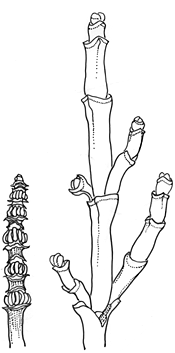Last month we were in the mud looking at mangroves, this month we’ll go slightly closer shoreward and take a look at what grows in the hypersaline environment of the Salt Marshes.
Salt Marshes occur around the high tide zone, often in shallow depressions which fill on the highest tides becoming more and more saline as water evaporates leaving salt behind. Unsurprisingly this is a very harsh environment to make a living in.
While they are often low in plant diversity, sometimes with only one or two species of plants they make great habitat for all sorts of critters from crabs and fish fingerlings through to a range of birds doing their best to eat those small critters and in some cases provide a relatively safe place to nest.
One evolutionary strategy to deal with the high salt levels is to store the salt within the plant, plants which do this are known as Halophytes. Two common halophytes found in the Hunter and Central Coast areas are Sarcocornia quinqueflora (Beaded Glasswort or Samphire) and Suaeda australis (Seablite) both are succulent and adapted to highly saline conditions with Sarcocornia often forming monocultures in areas where nothing else will survive. It’s unsurprising they are both in the Saltbush (Chenopodiaceae) family. Both species are also edible, a quick blanch in boiling water with Seablite tasting like a salty snow pea, I’ve only ever tried Samphire raw and it wasn’t that appetising.
Coastal Saltmarsh is listed as an endangered community so it’s best leaving the plants to the crabs.
Sarcocornia quinquefloraIllustration from https://plantnet.rbgsyd.nsw.gov.au/cgi-bin/NSWfl.pl?page=nswfl&lvl=in&name=Sarcocornia~quinquefloraPhoto T.M. Tame ©The Royal Botanic Gardens & Domain Trust
Suaeda australis
Images from: https://keys.lucidcentral.org/keys/v3/scotia/key/Plants%20and%20Fungi%20of%20south%20western%20NSW/Media/Html/Suaeda_australis.htm
For further information on Salt Marsh:
https://www.dpi.nsw.gov.au/__data/assets/pdf_file/0007/459628/Coastal-Saltmarsh-Primefact.pdf
http://era.daf.qld.gov.au/id/eprint/7079/1/saltmarsh-field-guide.pdf





